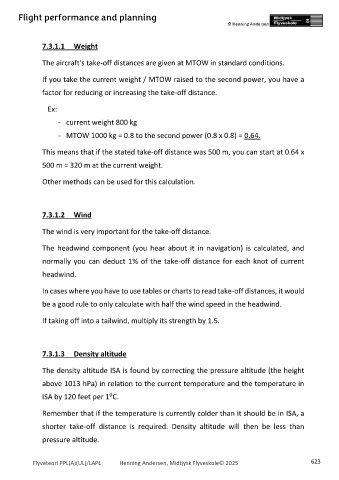Page 623 - PPL-engelsk 2025
P. 623
Flight performance and planning
7.3.1.1 Weight
The aircraft's take-off distances are given at MTOW in standard conditions.
If you take the current weight / MTOW raised to the second power, you have a
factor for reducing or increasing the take-off distance.
Ex:
- current weight 800 kg
- MTOW 1000 kg = 0.8 to the second power (0.8 x 0.8) = 0.64.
This means that if the stated take-off distance was 500 m, you can start at 0.64 x
500 m = 320 m at the current weight.
Other methods can be used for this calculation.
7.3.1.2 Wind
The wind is very important for the take-off distance.
The headwind component (you hear about it in navigation) is calculated, and
normally you can deduct 1% of the take-off distance for each knot of current
headwind.
In cases where you have to use tables or charts to read take-off distances, it would
be a good rule to only calculate with half the wind speed in the headwind.
If taking off into a tailwind, multiply its strength by 1.5.
7.3.1.3 Density altitude
The density altitude ISA is found by correcting the pressure altitude (the height
above 1013 hPa) in relation to the current temperature and the temperature in
ISA by 120 feet per 1⁰C.
Remember that if the temperature is currently colder than it should be in ISA, a
shorter take-off distance is required. Density altitude will then be less than
pressure altitude.
Flyveteori PPL(A)(UL)/LAPL Henning Andersen, Midtjysk Flyveskole© 2025 623

